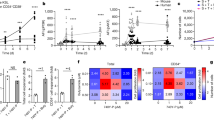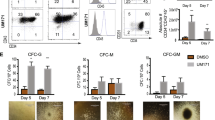Abstract
Expansion of haemopoietic stem cells is proposed to combat graft failure in adult recipients following cord blood (CB) transplantation. Cultures are traditionally performed in medium containing FCS, but to transfer expansion to the clinic, ‘good manufacturing practice’ (GMP) standards are required. This study evaluated expansion cultures in culture bags and serum-free (SF) conditions, to comply with GMP, by analysing sub-populations of CD34+ cells, colony-forming cells (CFC) and long-term culture initiating cells (LTC-IC). CD34+cell analysis has previously been used to measure clonogenic capacity and the CD34+CD38neg surface phenotype to measure primitive cell numbers. In this study, comparison of expansion in serum-replete medium with that in SF conditions demonstrated a lack of expression of CD38 on CD34+ cells in the absence of serum. These findings must be considered in clinical studies using in vitro expansion in SF conditions, and the CD34+CD38neg phenotype should not be used to confirm maintenance, or expansion, of primitive progenitor cells. Bone Marrow Transplantation (2001) 27, 365–371.
This is a preview of subscription content, access via your institution
Access options
Subscribe to this journal
Receive 12 print issues and online access
$259.00 per year
only $21.58 per issue
Buy this article
- Purchase on Springer Link
- Instant access to full article PDF
Prices may be subject to local taxes which are calculated during checkout


Similar content being viewed by others
References
Locatelli F, Rocha V, Chastang C et al. Factors associated with outcome after cord blood transplantation in children with acute leukemia Blood 1999 93: 3662–3671
Gluckman E, Broxmeyer HA, Auerbach AD et al. Hematopoietic reconstitution in a patient with Fanconi's anemia by means of umbilical-cord blood from an HLA-identical sibling New Engl J Med 1989 321: 1174–1178
Rubinstein P, Carrier C, Scaradavou A et al. Outcomes among 562 recipients of placental-blood transplants from unrelated donors New Engl J Med 1998 339: 1565–1577
Craig W, Kay R, Cutler RL, Lansdorp PM . Expression of Thy-1 on human hematopoietic progenitor cells J Exp Med 1993 177: 1331–1342
Baech J, Johnsen HE . Technical aspects and clinical impact of hematopoietic progenitor subset quantification Stem Cells 2000 18: 76–86
Wagner JE, DeFor T, Rubinstein P, Kurtzberg J . Transplantation of unrelated donor umbilical cord blood (UCB): outcomes and analysis of risk factors Blood 1997 90: (Suppl. 1) 398 (Abstr. 1767)
Gluckman E, Rocha V, Boyer-Chammard A et al. Outcome of cord-blood transplantation from related and unrelated donors New Engl J Med 1997 337: 373–381
Donaldson C, Armitage WJ, Laundy V et al. Impact of obstetric factors on cord blood donation for transplantation Br J Haematol 1999 106: 128–132
Piacibello W, Sanavio F, Garetto L et al. Extensive amplification and self-renewal of human primitive hematopoietic stem cells from cord blood Blood 1997 89: 2644–2653
Denning-Kendall PA, Nicol A, Horsley H et al. Is in vitro expansion of human cord blood cells clinically relevant? Bone Marrow Transplant 1998 21: 225–232
De Bruyn C, Delforge A, Bron D et al. Ex vivo expansion of CD34+ CD38− cord blood cells J Hematother 1997 6: 93–102
Shih CC, Hu MC, Hu J et al. Long-term ex vivo maintenance and expansion of transplantable human hematopoietic stem cells Blood 1999 94: 1623–1636
Bharucha C, Elliott S, Campbell D et al. The Belfast Cord Blood Bank Ulster Med J 1997 66: 9–12
Warwick RM, Barbara JA . Safety aspects of cord blood banking Bone Marrow Transplant 1998 21: (Suppl. 3) S40–42
Kogler G, Nurnberger W, Fischer J et al. Simultaneous cord blood transplantation of ex vivo expanded together with non-expanded cells for high risk leukemia Bone Marrow Transplant 1999 24: 397–403
Gratama JW, Orfao A, Barnett D et al. Flow cytometric enumeration of CD34+ hematopoietic stem and progenitor cells. European Working Group on Clinical Cell Analysis Cytometry 1998 34: 128–142
Sutherland DR, Keating A, Nayar R et al. Sensitive detection and enumeration of CD34+ cells in peripheral and cord blood by flow cytometry Exp Hematol 1994 22: 1003–1010
Denning-Kendall P, Donaldson C, Nicol A et al. Optimal processing of human umbilical cord blood for clinical banking Exp Hematol 1996 24: 1394–1401
Conneally E, Cashman J, Petzer A, Eaves C . Expansion in vitro of transplantable human cord blood stem cells demonstrated using a quantitative assay of their lympho-myeloid repopulating activity in nonobese diabetic-scid/scid mice Proc Natl Acad Sci USA 1997 94: 9836–9841
Civin CI, Almeida-Porada G, Lee MJ et al. Sustained, retransplantable, multilineage engraftment of highly purified adult human bone marrow stem cells in vivo Blood 1996 88: 4102–4109
Donaldson C, Armitage WJ, Denning-Kendall PA et al. Optimal cryopreservation of human umbilical cord blood Bone Marrow Transplant 1996 18: 725–731
Nicol A, Nieda M, Donaldson C et al. Cryopreserved human bone marrow stroma is fully functional in vitro Br J Haematol 1996 94: 258–265
Strijbosch LW, Buurman WA, Does RJ et al. Limiting dilution assays. Experimental design and statistical analysis J Immunol Methods 1987 97: 133–140
Terstappen LW, Buescher S, Nguyen M, Reading C . Differentiation and maturation of growth factor expanded human hematopoietic progenitors assessed by multidimensional flow cytometry Leukemia 1992 6: 1001–1010
Dorrell C, Gan OI, Pereira DS et al. Expansion of human cord blood CD34(+)CD38(−) cells in ex vivo culture during retroviral transduction without a corresponding increase in SCID repopulating cell (SRC) frequency: dissociation of SRC phenotype and function Blood 2000 95: 102–110
Acknowledgements
This work was funded by the Leukaemia Research Fund grant 98/47. We thank the midwives on Delivery Suite, Southmead Hospital, all mothers who donated CB for the project and Graham Molineux (Amgen) for the gift of growth factors, ‘Modified Ex-vivo Expansion Medium’ and culture bags.
Author information
Authors and Affiliations
Rights and permissions
About this article
Cite this article
Donaldson, C., Denning-Kendall, P., Bradley, B. et al. The CD34+CD38neg population is significantly increased in haemopoietic cell expansion cultures in serum-free compared to serum-replete conditions: dissociation of phenotype and function. Bone Marrow Transplant 27, 365–371 (2001). https://doi.org/10.1038/sj.bmt.1702810
Received:
Accepted:
Published:
Issue Date:
DOI: https://doi.org/10.1038/sj.bmt.1702810
Keywords
This article is cited by
-
Optimization of adenovirus serotype 35 vectors for efficient transduction in human hematopoietic progenitors: comparison of promoter activities
Gene Therapy (2005)
-
Clinical application of hematopoietic progenitor cell expansion: current status and future prospects
Bone Marrow Transplantation (2003)
-
Role of different medium and growth factors on placental blood stem cell expansion: an in vitro and in vivo study
Bone Marrow Transplantation (2002)



